揭示地下应力与地貌特征之间的联系
IF 4.6
1区 地球科学
Q1 GEOSCIENCES, MULTIDISCIPLINARY
引用次数: 0
摘要
构造应力场诱发地表变形。在长波波段,岩石圈的非均质性(地壳和岩石圈地幔厚度和密度的变化)和地幔对流的基底牵引力都是应力场的组成部分。在这里,我们分析了主要水平构造应力、断层迹线和河流流向的全球走向,以推断深部地下应力是否以及如何控制地貌特征。发现断层迹线方向与Anderson断层理论预测一致。河流方向大部分与断层轨迹一致,部分与应力方向一致。走向的程度取决于断层制度、应力源和河流顺序。岩石圈结构变化的应力最能预测伸展断裂,而地幔流的应力最能预测挤压断裂。我们提出了一个度量来量化地幔流动或岩石圈非均质性对地表特征的相对影响,这为岩石圈强度提供了一个代理。本文章由计算机程序翻译,如有差异,请以英文原文为准。
Unraveling the Connection Between Subsurface Stress and Geomorphic Features
The tectonic stress field induces surface deformation. At long wavelengths, both lithospheric heterogeneity (changes in the thickness and density of crust and lithospheric mantle) and basal tractions from mantle convection contribute to the stress field. Here, we analyze the global alignment of principal horizontal tectonic stresses, fault traces, and river flow directions to infer whether and how deep subsurface stresses control geomorphic features. We find that fault trace orientations are consistent with predictions from Anderson's fault theory. River directions largely align with fault traces and partly with stresses. The degree of alignment depends on fault regime, the source of stress, and river order. Extensional faulting is best predicted by stresses from lithospheric structure variations, while compressive faulting is best predicted by stresses from mantle flow. We propose a metric to quantify the relative influence of mantle flow or lithospheric heterogeneity on surface features, which provides a proxy for lithospheric strength.
求助全文
通过发布文献求助,成功后即可免费获取论文全文。
去求助
来源期刊

Geophysical Research Letters
地学-地球科学综合
CiteScore
9.00
自引率
9.60%
发文量
1588
审稿时长
2.2 months
期刊介绍:
Geophysical Research Letters (GRL) publishes high-impact, innovative, and timely research on major scientific advances in all the major geoscience disciplines. Papers are communications-length articles and should have broad and immediate implications in their discipline or across the geosciences. GRLmaintains the fastest turn-around of all high-impact publications in the geosciences and works closely with authors to ensure broad visibility of top papers.
 求助内容:
求助内容: 应助结果提醒方式:
应助结果提醒方式:


